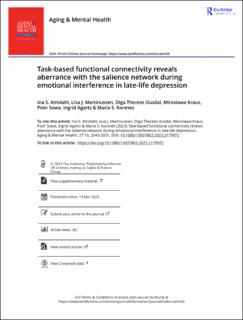| dc.contributor.author | Almdahl, Ina Selseth | |
| dc.contributor.author | Martinussen, Liva Jenny | |
| dc.contributor.author | Ousdal, Olga Therese | |
| dc.contributor.author | Kraus, Miroslawa | |
| dc.contributor.author | Sowa, Piotr | |
| dc.contributor.author | Agartz, Ingrid | |
| dc.contributor.author | Korsnes, Maria Stylianou | |
| dc.date.accessioned | 2023-09-22T11:11:33Z | |
| dc.date.available | 2023-09-22T11:11:33Z | |
| dc.date.created | 2023-03-25T14:26:40Z | |
| dc.date.issued | 2023 | |
| dc.identifier.issn | 1360-7863 | |
| dc.identifier.uri | https://hdl.handle.net/11250/3091335 | |
| dc.description.abstract | Objectives
Late-life depression (LLD) is a common and debilitating disorder. Previously, resting-state studies have revealed abnormal functional connectivity (FC) of brain networks in LLD. Since LLD is associated with emotional-cognitive control deficits, the aim of this study was to compare FC of large-scale brain networks in older adults with and without a history of LLD during a cognitive control task with emotional stimuli.
Methods
Cross-sectional case-control study. Twenty participants diagnosed with LLD and 37 never-depressed adults 60–88 years of age underwent functional magnetic resonance imaging during an emotional Stroop task. Network-region-to-region FC was assessed with seed regions in the default mode, the frontoparietal, the dorsal attention, and the salience networks.
Results
FC between salience and sensorimotor network regions and between salience and dorsal attention network regions were reduced in LLD patients compared to controls during the processing of incongruent emotional stimuli. The normally positive FC between these networks were negative in LLD patients and inversely correlated with vascular risk and white matter hyperintensities.
Conclusions
Emotional-cognitive control in LLD is associated with aberrant functional coupling between salience and other networks. This expands on the network-based LLD model and proposes the salience network as a target for future interventions. | en_US |
| dc.language.iso | eng | en_US |
| dc.publisher | Taylor & Francis | en_US |
| dc.rights | Attribution-NonCommercial-NoDerivatives 4.0 Internasjonal | * |
| dc.rights.uri | http://creativecommons.org/licenses/by-nc-nd/4.0/deed.no | * |
| dc.title | Task-based functional connectivity reveals aberrance with the salience network during emotional interference in late-life depression | en_US |
| dc.type | Journal article | en_US |
| dc.type | Peer reviewed | en_US |
| dc.description.version | publishedVersion | en_US |
| dc.rights.holder | Copyright 2023 The Author(s) | en_US |
| cristin.ispublished | true | |
| cristin.fulltext | original | |
| cristin.qualitycode | 1 | |
| dc.identifier.doi | 10.1080/13607863.2023.2179972 | |
| dc.identifier.cristin | 2136907 | |
| dc.source.journal | Aging & Mental Health | en_US |
| dc.source.pagenumber | 2043-2051 | en_US |
| dc.identifier.citation | Aging & Mental Health. 2023, 27, 2043-2051. | en_US |
| dc.source.volume | 27 | en_US |

